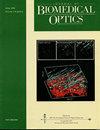Deep learning–enabled fluorescence imaging for surgical guidance: in silico training for oral cancer depth quantification
IF 3
3区 医学
Q2 BIOCHEMICAL RESEARCH METHODS
引用次数: 0
Abstract
SignificanceOral cancer surgery requires accurate margin delineation to balance complete resection with post-operative functionality. Current in vivo fluorescence imaging systems provide two-dimensional margin assessment yet fail to quantify tumor depth prior to resection. Harnessing structured light in combination with deep learning (DL) may provide near real-time three-dimensional margin detection.AimA DL-enabled fluorescence spatial frequency domain imaging (SFDI) system trained with in silico tumor models was developed to quantify the depth of oral tumors.ApproachA convolutional neural network was designed to produce tumor depth and concentration maps from SFDI images. Three in silico representations of oral cancer lesions were developed to train the DL architecture: cylinders, spherical harmonics, and composite spherical harmonics (CSHs). Each model was validated with in silico SFDI images of patient-derived tongue tumors, and the CSH model was further validated with optical phantoms.ResultsThe performance of the CSH model was superior when presented with patient-derived tumors (P-value<0.05). The CSH model could predict depth and concentration within 0.4 mm and 0.4 μg/mL, respectively, for in silico tumors with depths less than 10 mm.ConclusionsA DL-enabled SFDI system trained with in silico CSH demonstrates promise in defining the deep margins of oral tumors.用于手术指导的深度学习荧光成像:口腔癌深度量化的硅学训练
意义口腔癌手术需要准确的边缘划分,以兼顾完整切除和术后功能。目前的体内荧光成像系统可提供二维边缘评估,但无法在切除前量化肿瘤深度。利用结构光结合深度学习(DL)可提供近乎实时的三维边缘检测。方法设计了一个卷积神经网络,从 SFDI 图像中生成肿瘤深度和浓度图。为训练卷积神经网络架构,开发了三种口腔癌病灶的硅学表征:圆柱体、球谐波和复合球谐波(CSHs)。每个模型都通过患者舌部肿瘤的硅学 SFDI 图像进行了验证,CSH 模型则通过光学模型进行了进一步验证。对于深度小于 10 毫米的硅学肿瘤,CSH 模型可预测的深度和浓度分别为 0.4 毫米和 0.4 微克/毫升。
本文章由计算机程序翻译,如有差异,请以英文原文为准。
求助全文
约1分钟内获得全文
求助全文
来源期刊
CiteScore
6.40
自引率
5.70%
发文量
263
审稿时长
2 months
期刊介绍:
The Journal of Biomedical Optics publishes peer-reviewed papers on the use of modern optical technology for improved health care and biomedical research.

 求助内容:
求助内容: 应助结果提醒方式:
应助结果提醒方式:


